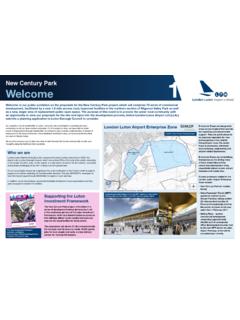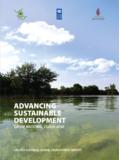Transcription of London Luton Airport Vision for Sustainable …
1 Airport LtdLondon A Luton Council companyLondon Luton Airport Vision for Sustainable Growth I Foreword04 I At a glance06 I 01. Context10 I 02. LTN s success14 I 03. The Vision 18 I 04. LTN s contributions24 I 05. Being a good neighbour26 I 06. Conclusion025thLARGEST Airport in UKLTN NOWF orewordI am delighted to introduce our Vision for London Luton Airport s (LTN) Sustainable Growth 2020-2050. This is an important document for London Luton Airport Limited (LLAL), our partners at the Airport , our customers, our residents, our neighbours and the sub-regional and national economies. It sets out our Vision for LTN; to make best use of the existing runway to provide the maximum benefit to the local and sub-regional economy, delivering good levels of service to our customers, and effectively managing the environmental impacts in line with our commitment to responsible and Sustainable development.
2 The publication of our Vision is timely, as aviation strategy and Airport capacity in the South-East of England are matters currently being consulted on by the Government as part of the development of a UK Aviation Strategy. LTN is a major success story. It is the UK s fifth largest and one of the fastest growing major airports, having achieved 43 months of consecutive passenger growth. This success means it is currently forecast to reach its existing permitted capacity of 18 million passengers per year in the next three to four years. The economic benefits of LTN are easy to quantify. LTN is a vital element of the local and sub-regional economy, supporting more than 30,000 jobs and contributing billion per year into the UK economy, including more than 500m into Bedfordshire, Buckinghamshire and Hertfordshire. Through LLAL, LTN generates significant income for Luton Borough Council, paying for vital services and infrastructure investment.
3 Over the last five years, LLAL has also provided more than 50m for local charities, community and voluntary organisations in Luton and beyond in communities impacted by Airport operations. Through our work with Luton Borough Council (LBC) on its billion Luton Investment Framework, we are supporting the clear Vision of our shareholder, the Council, to achieve transformational economic and employment growth over the next 20 years, to support improved life chances, prosperity, health and wellbeing for all residents. In order to make sure the Airport continues to thrive, and increases its contribution to the sub-regional economy and the UK s aviation sector, we are planning to increase LTN s capacity over the long term. A lot of work needs to be done to understand the achievable capacity of LTN, and how the needs of airlines, passenger experience and the Sustainable growth of the sub-regional economy can be will work tirelessly to keep you informed.
4 We will share proposals as they develop, and will make sure everyone has an opportunity to feed into the process. All comments provided will be very carefully considered for the future of our Sustainable Vision for LTN signals our commitment to be open, inclusive and transparent as we work to drive forward a more modern, efficient, and environmentally and socially responsible LTN. We hope you will join our Andy MalcolmChair of London Luton Airport Ltd3 LARGEST Airport in UKAt a glance04 Ownership and operationsLTN is owned by London Luton Airport Ltd (LLAL). Our company is in turn wholly owned by Luton Borough is operated by London Luton Airport Operations Ltd (LLAOL), which is owned by a consortium, on a concession until (LLAL) are considering the long-term future of the Airport and investing some of the income that we receive from LTN in this for national aviationAviation is a strategic economic sector for the UK and the Government is developing a national Aviation Strategy.
5 We responded to a recent consultation, agreeing with the Government that airports should be focusing on making best use of their existing for air travel is set to rise over the next 30 years and the need for the UK to be well connected to the global economy is more important than airports in the UK have a role to play in this. There is therefore a vital need to plan LTN s long-term todayIn 2014, planning permission was granted to LLAOL to increase the capacity of LTN to 18 million passengers per annum (mppa). It was forecast at the time that this would be achieved by 2026 then, passenger numbers have increased by around one mppa in each of the last four years. Capacity is now expected to be reached within three are investing in the Airport , including the Luton DART (Direct Air to Rail Transit) which will transform public transport access to AVIATION Airport IN EUROPE3rdLARGESTLT N NOWThe economic opportunityLTN plays a vital role in the local and sub-regional economies.
6 It is estimated that every million additional passengers at LTN delivers around 800 new jobs and 76m into the regional overall potential of LTN could be worth in the region of billion to the UK, billion within Bedfordshire, Buckinghamshire and responsibility is to make sure that LTN adapts to meet changing airline and passenger needs, and that the benefits are felt across the region through inclusive growth. Community commitmentsWe are committed to helping LBC deliver the Luton Investment Framework, aimed at achieving transformational economic and employment growth, improving skills, wellbeing and life chances for our company, LTN generates significant income for LBC, paying for vital services and are a significant supporter of local voluntary and community groups through our per year Community Funding Vision To make the best use of the existing runway at LTN to provide the maximum benefit to the local and sub-regional economy; to deliver good levels of service; and to actively manage environmental impacts at the local and wider levels in line with our commitment to responsible and Sustainable development.
7 Our assessment is that the capacity of the existing runway is 36-38 mppa, or in the region of 240,000 aircraft movements per be clear, we will not be proposing either a second or an extended responsibilitiesWe take our responsibilities to our neighbours and the environment very understand that Airport operations can bring adverse impacts, and we will work hard to minimise and mitigate these as we develop our plan. We are currently setting out our plans for improvement within a new long-term environmental strategy for the are committed to undertaking full engagement and consultation with all those who have an interest in LTN s way forwardWe have put together a team of technical advisers to help us understand the potential of the Airport , based on its constraints. The initial result will be a masterplan outlining what this potential is, and how it can be intend to begin consultation with stakeholders and neighbouring communities on this emerging masterplan in mid-2018.
8 If the proposed increase is above 10mppa, we anticipate we will need to submit a Development Consent Order application to the Planning Inspectorate as it would be considered a Nationally Significant Infrastructure Project (NSIP).For local businesses We will offer greater opportunities to local communities We will be a better our passengers We will improve choice and your our airlines We will enable you to key objectivesAviation is a strategic economic sector for the UK, and the Government is currently consulting on the draft UK Aviation Strategy which sets out the long-term direction for aviation policy-making for 2050 and beyond. The final Aviation Strategy is anticipated to be published by the end of 2018 and will have at its core the Government s recognition that aviation is an important vehicle for growth and crucial to building a strong economy, creating jobs and supporting growth right across the UK.
9 In the Foreword of Aviation Strategy Call for Evidence, published July 2017, the Rt Hon Chris Grayling MP, Secretary of State for Transport, states that: Aviation [the Aviation Strategy Call for Evidence] sets out our belief that there is a need for all airports in the UK to make best use of their existing runways, while giving due consideration to environmental The draft Strategy highlights that strong growth in passengers over the past five years, including in the South East of England is putting significant pressure on existing infrastructure, despite significant financial investments by airports over the past decade . It goes on to confirm that the government agrees with the Airports Commission s recommendation that there is a requirement for more intensive use of existing Airport capacity and is minded to be supportive of all airports who wish to make best use of their existing runways including those in the South East.
10 We responded to the Call for Evidence, setting out our agreement with the Government that airports should be focusing on making best use of their existing runways, outlining LTN s strengths and setting out this long-term sector 532mcurrent asset valueLTN NOWW hilst the Government is minded to support the expansion of London Heathrow (LHR) through a third runway, this will not be completed until circa 2027 at the earliest. LTN and LHR play different roles and serve different markets in the UK aviation sector. LTN predominantly serves short-haul destinations while LHR focuses on its role as the one of the major European hub airports. We believe that the development of the infrastructure at LTN will deliver valuable runway capacity to meet the specific needs of its catchment area for mainly short-haul point-to-point journeys. The Government, via its Aviation Strategy consultation, agrees with the Airports Commission s recommendation that there is a requirement for more intensive use of existing Airport capacity and is minded to be supportive of all airports who wish to make best use of their existing runways, including those in the South-East, alongside the provision of a new runway at latest forecasts by the Department for Transport (DfT October 2017) show the total number of air passengers travelling to and from the UK as reaching 470-535 million by 2050, with a mid-range position of 495 million, up from some 277 million today, and showing that without further capacity development LTN will be full by , Government statistics indicate that air passenger demand across the UK is set to rise over the next 30 years.



